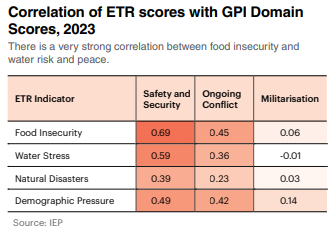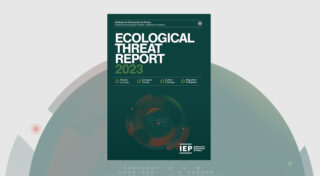Findings from the Ecological Threat Report reveal significant correlations between the prevalence of ecological threats (food insecurity, water stress, natural disasters, demographic pressures) and the three Global Peace Index domains (the level of Societal Safety and Security, the extent of Ongoing Domestic and International Conflict and the degree of Militarisation).

The prevalence of all four ecological threats increases where countries are less peaceful in the Safety and Security and Ongoing Conflict domains. Militarisation is the only domain not strongly correlated to ecological threat. The strong relationship between peacefulness and ecological threats highlights that less peaceful countries have a higher prevalence of ecological threats, particularly food insecurity and water stress.
The strongest relationship is between the prevalence of food security and Safety and Security, with a correlation coefficient of 0.69. This is followed by the relationship between water risk and Safety and Security, with a correlation coefficient of 0.59. These relationships would be expected as food insecurity and water risk can be either an exacerbating factor or direct result of conflict, violence or political instability.
Increased ecological threats from a changing climate will have security implications at the micro and macro levels. When local communities experience ecological shocks, they can then lead to political instability when the country’s levels of resilience are low.
For example, when a record breaking drought in Kenya’s rift valley limited access to land and water in the region, pre-existing conflict and grievances amongst herders and farmers were amplified, with conflict in the region resulting in 200 deaths in 2021. Similarly, in South Sudan, ongoing conflict and a multiyear drought drove unprecedented levels of food insecurity.
Security can also be affected when mitigating actions taken by one community negatively affects another. This has been seen in the hydroelectric dams and irrigation systems. Examples include dams in Türkiye, China and Ethiopia that restricted access to water in downstream countries.
A consequence of natural disasters, water scarcity, food insecurity, and above-average temperature is that they cause migration and displacement. Individuals fleeing harm can add more pressure to areas that are not directly affected by the disaster. Migration can intensify competition over jobs, housing, and other resources.
Explore the relationship between conflict, ecological threat, and climatic changes in the Ecological Threat Report 2023.

Download the Ecological Threat Report 2023
Ecological Threat Report 2023